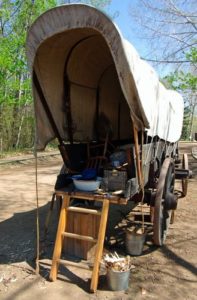Fort Edmonton Park is on the South bank of the South Saskatchewan River in Edmonton. It traces the development from a fur trading area to booming metropolitan area. The 1846 Hudson Bay Trading Fort, 1880s, 1910 and 1920 settlement have been reconstructed. We particularly enjoyed the fort and the 1880s street. The 1905 street was less interesting. and the 1920s street was disappointing as many of the buildings were eateries or gift shops. None sold guide books or postcards.
There is a steam train ride from the ticket entrance to the fort. This is in a 1904 coach complete with drop down beds.
The fort is surrounded by a wooden stockade. Inside is a large open grass area with buildings scattered around. John Rowand was the chief Factor and his house was one of the largest built in its time. It is splendid inside and has been furnished as it might have been when John Rowand lived there. There was a small chapel with accommodation for the pries. Scattered round are barrack blocks for the men, tradesmen’s quarters and the Indian Trade Store. Indian traders brought furs to trade with the Hudson Bay company for merchandise. The York boats made the long journey with furs down the river to the boats in Hudson Bay and returned loaded with goods from England.
Outside the fort is a small Cree settlement with wigwams. Cree women were frying bannocks on a pan over an open fire and offering them to visitors. They were excellent.
It is a short walk through the trees to the 1880s street passed a settlers wagon which would have been used for transporting a family and their belongings from the railhead to their new home. These were pulled by oxen who would feed on wayside vegetation. Horses were more susceptible to disease and fodder had to be carried.
There was another wagon with an attorney selling land plots to prospective settlers.
The 1885 street was wide with wooden boardwalks, much needed during rain when the road would become very muddy. Horse drawn wagons would have been used for all transport and provide rides for visitors.
There is a selection of buildings from the early days of the town with Methodist Mission and telegraph and printing press and hotel, which was Edmonton’s first brick building. The railway arrived in 1891. It was an important stopping off place for supplies for the Yukon Gold rush.
There is a selection of shops including Hardware, Harness shop, general store, Blacksmith and a saloon. For the ladies there was a milliners and jewellers shop. The NW Mounted police had an outpost and jail here and there was a Dominion’s Land Office. A fur store with warehouse behind handled all fur trade after the demise of the Hudson Bay Company.
The 1905 street covers the era from 1892-1914 when there was an economic boom as small businesses developed and Edmonton was established as a city with the Alberta Provincial Legislature and the opening of the University of Alberta. All major businesses associated with a town appeared. There was a fire hall, police station, bank and post office. A Masonic Hall was built and a dentist set up in business. Houses were larger and better furnished. Farms were prosperous with outbuildings and large barns.
Rapid development lead to a housing shortage and the development of a ‘tent city’. Standards were carefully regulated and controlled and tents were inspected to make sure standards were met. The fur trade was decreasing and the fort was demolished in 1911.
The 1920s street represents the era from 1914 -29. Smaller businesses were being replaced by larger business chains. A large hotel was built which boasted Canada’s longest bar. There was a telephone exchange. The motor car had arrived and there was motordrome selling cars, accessories and petrol. Tramcars run along the street and provide transport for visitors.
There are costumed interpreters around the site. All are excellent and knowledgeable. They don’t stick rigidly to their role and will broaden the conversation to cover more recent history.
We were looking around one of the 1880s houses when a tourist came in and asked the costumed interpreter if she lived there all year. There was was no TV and he asked how she managed without a TV set. Quick as a flash came the reply “what is a TV set?” The guy was at a loss for words at that point and we heard him go out telling his family “she lives here all year…. can you imagine it in winter… how do they manage without TV?”
We spent a thoroughly enjoyable day here. It is informative and an enjoyable way to learn about the early history and development of Edmonton.
Website: www.fortedmontonpark.ca/
Our pictures of Fort Edmonton are here.
The 1885 street are here: http://wasleys.org.uk/Canada/canada_09_mw/05FortEdmonton2/index.html
The 1905 street are here: http://wasleys.org.uk/Canada/canada_09_mw/06FortEdmonton3/index.html
The 1920s street are here: http://wasleys.org.uk/Canada/canada_09_mw/06FortEdmonton3/index.html
We visited here as part of a five week trip to Canada. There is an overall report of the trip here.
I have written a series of detailed reports for some of the places visited for Silver Travel.








